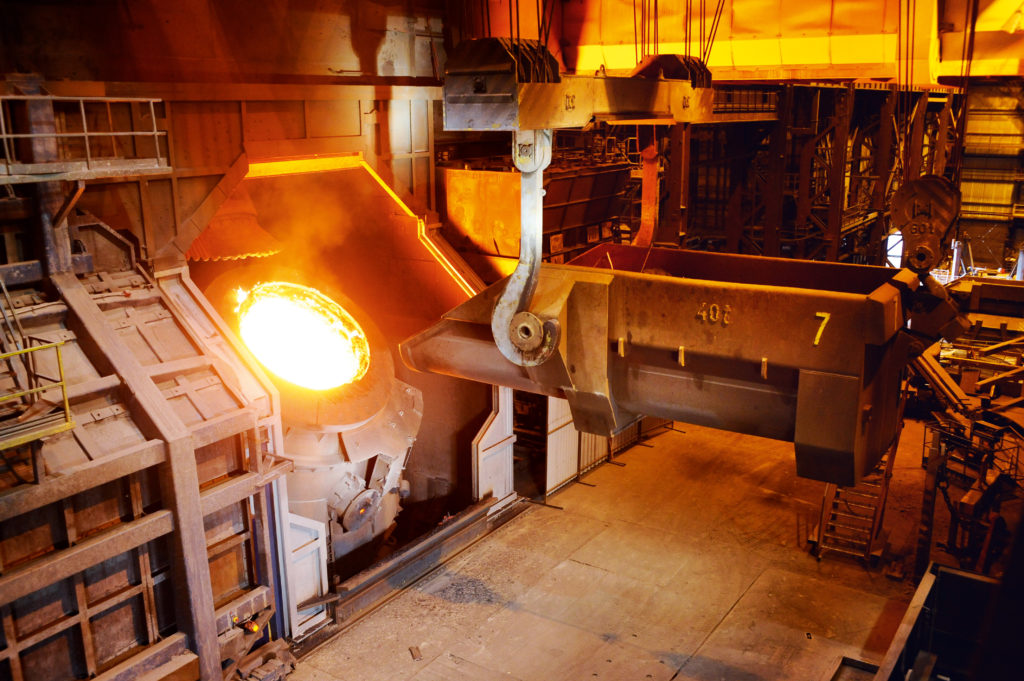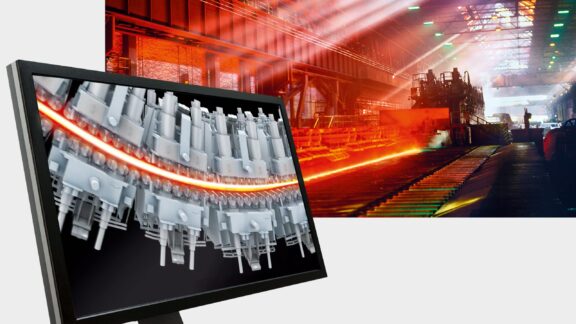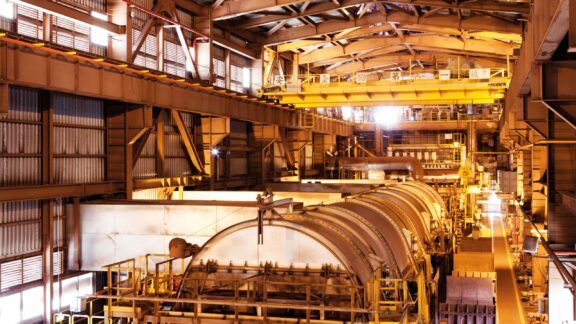This post is also available in: 简体中文 (Chinese (Simplified))
With the steel industry under increasing pressure to make production more environmentally friendly, many steel producers are looking for short-term and cost-effective solutions for making their existing plants greener. Primetals Technologies believes that, in many cases, an evolutionary approach is appropriate: an incremental increase of the scrap and hot-briquetted iron (HBI) rate in converter-based steelmaking can lead to greener and more sustainable steel production.
Steel is actually a very sustainable material, because it is easy to recycle with minimal or no loss in quality, provided proper collection sorting systems are in place. The CO2 emissions from the production of steel through the recycling of scrap or the use of hot-briquetted iron (HBI) are much lower compared to steel production from iron ore via the blast furnace or the direct-reduction route, primarily because all the reduction work is required for iron making only, while scrap only needs to be heated and melted.
Global steel production is still dominated by the integrated route, where hot metal is produced in the blast furnace and then refined in an LD (BOF) converter. While in some countries scrap-based steel production via the electric arc furnace (EAF) is prevalent, on a global scale it accounts for less than 20 percent of total steel production. Another way to produce steel is direct reduction, which is currently experiencing high growth rates, but globally its share is still comparatively low.
The number of LD (BOF) converters installed worldwide remains relatively stable, but the steel plants using them are coming under increasing pressure to raise the scrap rate in order to reduce CO2 emissions. Technologies for increasing the scrap rate already exist and can be implemented as a short-term solution for reducing CO2 emissions in steel making, thereby avoiding any major investment in building completely new facilities.
In order to increase the scrap rate in existing converter plants, steel producers will have to overcome three main challenges.

Scrap logistics
The first challenge involves putting in place an adequate transport infrastructure, so that the scrap can be transported to the plant for storage prior to its final use in the converter. The storage area has to be able to cope with the clear separation of different scrap qualities, which ensures the cost-effective use of the scrap. The scrap then has to be transported and loaded into the converter using scrap chutes. Depending on the scrap rate and space restrictions, two chutes per heat are required to achieve higher scrap rates, which can result in longer charging times and reduced plant productivity unless appropriate countermeasures are implemented.

Steel quality
The converter is the perfect aggregate to refine the steel and to remove elements such as silicon, carbon, phosphorus, or sulfur from the hot metal charged to the converter. However, there are trace elements like copper, chromium, and nickel that negatively impact steel quality but cannot be removed from the melt in the converter or through secondary metallurgy. This is why a scrap-sorting system and careful scrap quality control are required: they ensure that not too many undesirable trace elements are added to the heat in the first place. Additional process models are employed to calculate the degree to which trace elements will end up in the final product, as well as the amount and quality of the scrap required.

Energy balance and scrap melting
The processing of scrap requires energy for heating and melting. In the converter process, this energy is provided by the combustion of carbon and silicon in the hot metal or by adding heating agents to the process. Since the amount of these combustibles is limited, the share of scrap that can be processed in a converter is limited to some 15 to 20 percent, unless the steps described in this article are taken.
Increasing the scrap rate
There are four main ways to incrementally increase the scrap (or HBI) rate and contribute toward greener steel production, ranging from simple solutions that can be implemented for existing BOF converters—like process models, scrap-preheating lances, and post combustion lances—to dedicated processes for the highest scrap rates like the Jet Process.
1. Converter Process Model
In typical LD (BOF) converter operations, cooling agents such as pig iron or iron ore are added toward the end of the process—if measurements indicate this measure is necessary—in order to achieve the target tapping temperature. With a modern process model from Primetals Technologies, it is possible to accurately predict and control the final chemical composition and temperatures of the heat, and no such cooling agents are required. As a result, all of the energy generated during the process can be used to melt scrap, which is charged right at the beginning of the process.
Furthermore, applying this kind of process model results in a reduction of the number of reblows and corrections, ultimately helping to stabilize production and reduce waiting times and, consequently, energy losses. In typical cases, the implementation of Primetals Technologies’ process model on the converter in conjunction with process optimization can increase the scrap rate by as much as four percent.
2. Scrap-Preheating Lance
Scrap is typically charged to the converter in cold condition. Preheating the scrap adds more energy to the steelmaking process and allows for a higher scrap rate. In order to avoid dust formation and emissions in the plant, preheating is best done inside the converter before the hot metal is charged. This allows the refractory-lined converter vessel to be used as a combustion chamber and the primary dedusting equipment for heat recovery and off-gas cleaning. Scrap preheating itself is done with a burner lance using natural gas, and the same lance can also be used for converter preheating after relining or during standby times.
In order to avoid extensive scrap oxidation, the preheating temperature needs to be limited to an average of 800 degrees Celsius; about ten minutes of preheating time is required to achieve this temperature. The additional energy input from preheating will allow the scrap rate to be increased by about five percent. This process is similar to the de-icing and drying process necessary in many northern countries when handling scrap in winter.
3. Dual-Flow Post-Combustion Lance
The combustion of silicon and carbon is what generates most of the energy in the converter. While silicon is fully combusted to SiO2, the carbon in the hot metal is only combusted in the reaction zone to CO. Additional oxygen needs to be supplied in a second step for post combustion in order to finally combust the CO to CO2and utilize the full energy potential of the carbon contained in the hot metal. This is best done using a dual-flow post-combustion lance, a lance equipped with an additional port where oxygen for post combustion is injected. Furthermore, a second control line is required to regulate the flow at the post-combustion port. This second line allows the post combustion to be controlled independently of the decarburization process.
The installation of a dual-flow post-combustion lance allows the rate of CO combusted to CO2 inside the converter to be increased from 12 to 20 percent. The additional energy generated this way makes a scrap-rate increase of as much as four percent possible.
4. Jet Process
The Jet Process combines a bottom-blowing converter equipped with lime and coal injection and a hot-blast lance for the highest-possible post combustion. This design results in an almost complete combustion of the coal—which is found in the hot metal and additionally injected—to CO2 inside the converter. This way, the chemical energy of the coal is used to the maximum extent possible; the resulting efficiency is higher than that of an electric arc furnace using electricity from a coal-based power plant.
For the LD (BOF) converter, it is possible to incrementally increase the scrap rate by implementation of the process model, scrap-preheating lance, and dual-flow post-combustion lance. But the maximum scrap rate is restricted to approximately 30 percent due to limited bath mixing in the converter, as all oxygen is blown from the top. To overcome this limit, the Jet Process uses bottom-blowing converter technology that allows for the melting of large scrap pieces, can use greater amounts of scrap in a reasonable timespan, and ensures that all scrap is molten before blowing ends.
The design of the Jet Process enables the highest possible post combustion as well as an excellent transfer of the generated heat to the steel bath. With the Jet Process, scrap rates of up to 50 percent are realistic, and thanks to its efficient use of coal, CO2 emissions are almost 40 percent lower compared to traditional converter-based steelmaking. A first industrial reference for the Jet Process was installed at POSCO, Korea, and the principles and advantages of the process have been proven.

Toward a greener future
Global steel production is still dominated by the integrated route, which uses LD (BOF) converters to refine the steel. The typical charge mix for this type of converter consists of 20 percent scrap and 80 percent hot metal from the blast furnace; the latter is responsible for the majority of the total CO2 emissions per ton of steel produced via the converter. The scrap rate—as well as the HBI rate—processed in the converter can be increased by more than 10 percent through the combined implementation of a process model, scrap-preheating lance, and dual-flow post-combustion lance—an easy upgrade for existing plants. For even higher scrap rates, the Jet Process is an excellent choice.
These improvement measures lead to a significant reduction in CO2 emissions per ton of steel produced, and can be implemented in existing plants in a short timeframe by re-using the available infrastructure. As a consequence, increasing the scrap or HBI rate in converter steelmaking is an essential short-term step toward more sustainable steel production, and is available for implementation today. It will allow the gap to be bridged until more advanced solutions—for instance, hydrogen-based technologies—are ready from a technical and commercial perspective for full industrial application.

Interview with
Dr. Gerald Wimmer
Dr. Gerald Wimmer is VP of Converter Steelmaking at Primetals Technologies. He believes that the converter still has great potential.
What in your view is the best upgrade for converter-based steelmaking facilities?
Dr. Gerald Wimmer: It’s impossible to choose only one—I think that the process model and dual-flow post combustion lance are versatile tools that can be easily implemented in all plants, with benefits in several dimensions. Producers all around the world are currently evaluating such implementations.
What is the outlook for converter steelmaking in your personal opinion?
Dr. Wimmer: In the long run, I hope we will manage to replace the existing blast-furnace-to-converter route with more sustainable processes that require fewer resources and less energy while generating less CO2 emissions. For the time being, converter steelmaking will remain the dominant process with lots of potential for improvement. Most potential steps for improving the process, such as increasing the scrap rate, are typical short-term measures: readily available and easy to implement.
Is there a new technology in steelmaking that you’re particularly excited about?
Dr. Wimmer: 90 years ago, the invention of the Linde-Fränkle process for low-cost oxygen generation paved the way for converter steelmaking as we know it. I expect a similar development to happen with what I consider the likely next step: hydrogen-based steelmaking.


